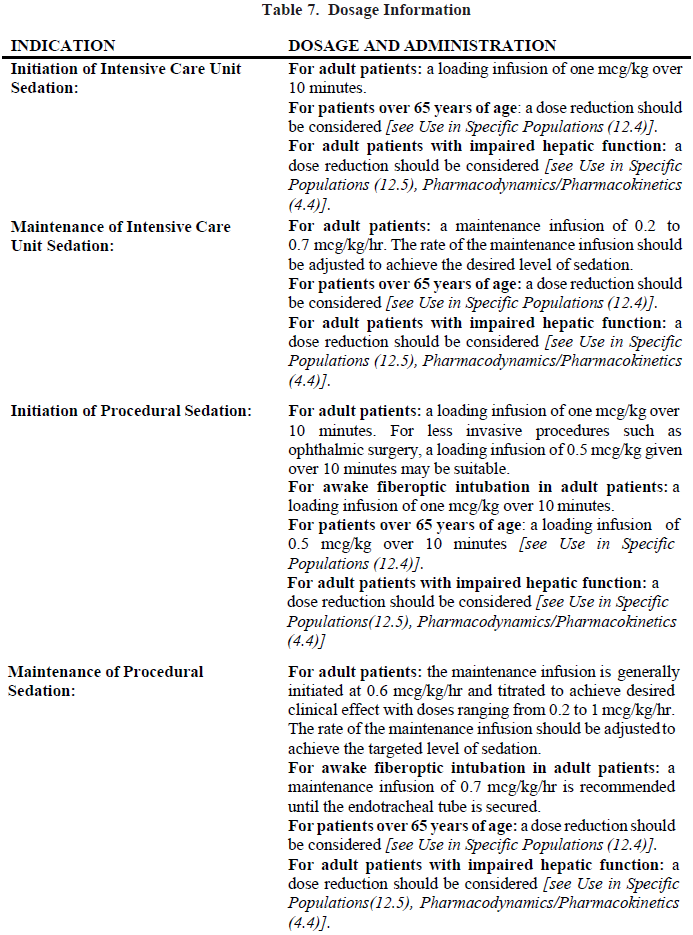DEXMEDETOMIDINE FRESENIUS CONCENTRATE FOR SOLUTION FOR INFUSION 100MCG/ML
7 Indications
Intensive Care Unit Sedation
Dexmedetomidine is indicated for sedation of initially intubated and mechanically ventilated patients during treatment in an intensive care setting. Dexmedetomidine should be administered by continuous infusion not to exceed 24 hours.
Dexmedetomidine has been continuously infused in mechanically ventilated patients prior to extubation, during extubation, and post-extubation. It is not necessary to discontinue dexmedetomidine prior to extubation.
Procedural Sedation
Dexmedetomidine is indicated for sedation of non-intubated patients prior to and/or during surgical and other procedures.
9 Contraindications
Hypersensitivity to the active substance or to any of the excipients in the formulation. Advanced heart block (grade 2 or 3) unless paced.
Uncontrolled hypotension.
Acute cerebrovascular conditions.
8 Recommended Dose and Mode of Administration
8.1 Dosing Guidelines
- Dexmedetomidine dosing should be individualized and titrated to desired clinical response.
- Dexmedetomidine is not indicated for infusions lasting longer than 24 hours.
- Dexmedetomidine should be administered using a controlled infusion device.
8.2 Dosing Information

8.3 Dosage Adjustment
Due to possible pharmacodynamic interactions, a reduction in dosage of dexmedetomidine or other concomitant anesthetics, sedatives, hypnotics or opioids may be required when co- administered [see Interactions with Other Medicaments (11.1) – please refer to the Product Insert/Patient Information Leaflet published on HSA for the full drug information ].
Dosage reductions may need to be considered for adult patients with hepatic impairment, and geriatric patients [see Warnings and Precautions (10.8), Use in Specific Populations (12.5), Pharmacodynamics/Pharmacokinetics (4.4) – please refer to the Product Insert/Patient Information Leaflet published on HSA for the full drug information ].
8.4 Preparation of Solution
The vials are intended for single patient use only.
Dexmedetomidine Fresenius can be diluted in the following infusion to achieve the required concentration of 4 micrograms/ml prior to administration:
- Sodium chloride 9 mg/mL (0.9%)
- Glucose 50 mg/mL (5%)
- Ringer’s solution
- Lactated Ringers
- Mannitol 200 mg/mL (20%)
For required concentration of 4 micrograms/ml:

The solution should be shaken gently to mix well.
Dexmedetomidine Fresenius should be inspected visually for particulate matter and discoloration prior to administration.
8.5 Administration with Other Fluids
Dexmedetomidine infusion should not be co-administered through the same intravenous catheter with blood or plasma because physical compatibility has not been established.
Dexmedetomidine has been shown to be incompatible when administered with the following drugs: amphotericin B, diazepam.
Dexmedetomidine has been shown to be compatible when administered with the following intravenous fluids and drugs:
0.9% sodium chloride in water, 5% dextrose in water, 20% mannitol, alfentanil hydrochloride, amikacin sulfate, aminophylline, amiodarone hydrochloride, ampicillin sodium, ampicillin sodium-sulbactam sodium, atracurium besylate, atropine sulfate, azithromycin, aztreonam, bretylium tosylate, bumetanide, butorphanol tartrate, calcium gluconate, cefazolin sodium, cefepime hydrochloride, cefoperazone sodium, cefotaxime sodium, cefotetan sodium, cefoxitin sodium, ceftazidime, ceftizoxime sodium, ceftriaxone sodium, cefuroxime sodium, chlorpromazine hydrochloride, cimetidine hydrochloride, ciprofloxacin, cisatracurium besylate, clindamycin phosphate, dexamethasone sodium phosphate, digoxin, diltiazem hydrochloride, diphenhydramine hydrochloride, dobutamine hydrochloride, dolasetron mesylate, dopamine hydrochloride, doxycycline hyclate, droperidol, enalaprilat, ephedrine hydrochloride, epinephrine hydrochloride, erythromycin lactobionate, esmolol, etomidate, famotidine, fenoldopam mesylate, fentanyl citrate, fluconazole, furosemide, gatifloxacin, gentamicin sulfate, glycopyrrolate bromide, granisetron hydrochloride, haloperidol lactate, heparin sodium, hydrocortisone sodium succinate, hydromorphone hydrochloride, hydroxyzine hydrochloride, inamrinone lactate, isoproterenol hydrochloride, ketorolac tromethamine, labetalol, lactated Ringer’s solution, levofloxacin, lidocaine hydrochloride, linezolid, lorazepam, magnesium sulfate, meperidine hydrochloride, methylprednisolone sodium succinate, metoclopramide hydrochloride, metronidazole, midazolam, milrinone lactate, mivacurium chloride, morphine sulfate, nalbuphine hydrochloride, nitroglycerin, norepinephrine bitartrate, ofloxacin, ondansetron hydrochloride, pancuronium bromide, phenylephrine hydrochloride, piperacillin sodium, piperacillin sodium-tazobactam sodium, potassium chloride, procainamide hydrochloride, prochlorperazine edisylate, promethazine hydrochloride, propofol, ranitidine hydrochloride, rapacuronium bromide, remifentanil hydrochloride, rocuronium bromide, sodium bicarbonate, sodium nitroprusside, succinylcholine, sufentanil citrate, sulfamethoxazole- trimethoprim, theophylline, thiopental sodium, ticarcillin disodium, ticarcillin disodium-clavulanate potassium, tobramycin sulfate, vancomycin hydrochloride, vecuronium bromide, verapamil hydrochloride, and a plasma-substitute.
8.6 Compatibility with Natural Rubber
Compatibility studies have demonstrated the potential for absorption of dexmedetomidine to some types of natural rubber. Although dexmedetomidine is dosed to effect, it is advisable to use administration components made with synthetic or coated natural rubber gaskets.